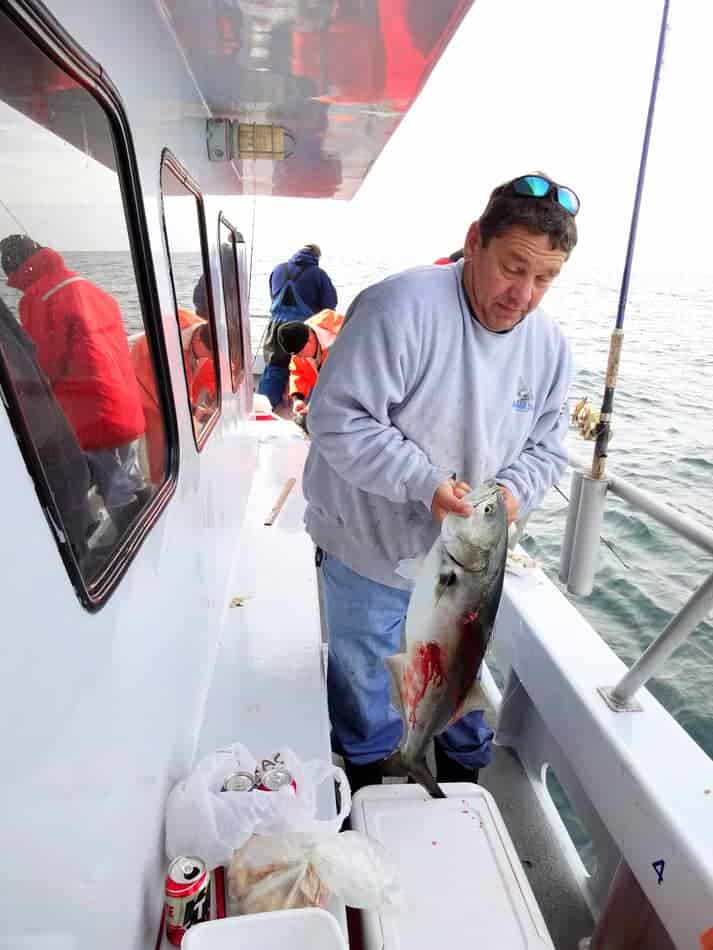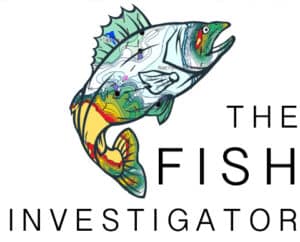
If you have never caught a Bluefish, you are in for a new exciting fishing adventure. Let’s look at how to catch Bluefish, where they live, and when is the best time to catch them.
How To Catch Bluefish
Bluefish are caught inshore and nearshore waters using various fishing methods, including trolling, pitching live baits, or casting artificial lures. Bluefish prefer topwater lures moving at high speeds. Bluefish have excellent eyesight, so using medium-light tackle is ideal.
As mentioned, Bluefish are caught using various methods, with trolling being the best fishing method to cover a lot of water and help you locate large Bluefish schools. Bluefish are predator fish, so fast trolling speeds ranging from 4 to 6 knots is ideal. When trolling, it is best to have a diverse spread. Trolling a diverse spread will better assist you in locating where in the water column the fish are and what colors and lure presentations they are currently striking.
When selecting your fishing spread, I recommend selecting lures specifically designed to swim in various water depths. For those unfamiliar with the term spread, a fishing spread is a selection of lures that are trolled behind the boat. While catching Bluefish, make sure to note the speed you were trolling and the type of lure they are constantly striking on. Once you notice a pattern, adjust your spread accordingly.
If, while trolling, you run into a large Bluefish school, it may be time to try your hand at casting artificial lures. Bluefish can be caught on a large assortment of artificial lures, including casting spoons, poppers, jigs, crankbaits, and twitch baits. It seems that no matter the situation, topwater lures, specifically “poppers,” are anglers preferred artificial lure.
When fishing artificial lures, it is important not to cast directly on top of the Bluefish school you are targeting, but instead cast a couple of yards past the school and quickly retrieve your lure through them. If you cast directly on top of the school, Bluefish often dart away into deeper water. Once spooked, it usually takes a couple of minutes for the school to resurface. Artificial lures work especially well on deep grass flats ranging from 10′ to 25′ in depth. Bluefish, especially the younger population, are known to congregate heavily on deep water grass flats in the spring and summer as they search for their next meal. Casting topwater or suspending baits over the grass flats during this time will dramatically increase your productivity on the water.
If you are looking for a more passive Bluefish fishing technique, you can try catching them by pitching live or cut baits. Fishing live or cut baits for Bluefish is an extremely productive method for hooking up to large Bluefish. This technique is prevalent amongst stationary anglers fishing shorelines and jetties. One of the drawbacks to fishing with live bait is the need to fish with a lighter tackle. Lighter tackle is excellent in that it increases the natural presentation of your bait, but its downfall is that it will significantly increase the number of break-offs that occur.
Expert Tips On Catching Bluefish
- Find the birds: If you find diving birds in nearshore waters, there is a good chance there are Bluefish in the water. Bluefish and birds have a symbiotic relationship where both species work together to hunt baitfish—bluefish circle around schools of baitfish, forcing them to the top of the water to get away. As the baitfish comes up to the top of the water, birds swiftly dive down and move them deeper into the water column. This “feeding frenzy” can happen for hours until the entire baitfish school is consumed.
- Check the Tides: Though Bluefish can be caught on any tide, a falling high tide is the fishiest time to get on the water and target Bluefish.
- Chum them up: Fishing for Bluefish can be hit or miss. There are times when you can locate large schools of Bluefish, but for some reason, they are completely disinterested in anything you pitch their way. If this happens, one way to turn them on is by heavily chumming up the water. We do this by putting out a chum bag while also taking handfuls of baitfish out of the Livewell and tossing them into the water. After a couple of minutes of chumming the waters, Bluefish become more aggressive, eventually striking our baits and lures.
- Drift the grass flats in summer: Bluefish can be easily targeted by floating deep water grass flats. If you can position your boat upwind or up-current (whichever is strongest) and allow the boat to float across the grass flats, there is a good chance you will hook up to a school of Bluefish. By floating the grass flats rather than driving around them using your engine will significantly increase your chances of keeping the school present without spooking them.
- Use Fluorocarbon leader: Many anglers recommend using wire leaders when targeting Bluefish to limit the amount of “cut-offs’ but by doing this, you will inadvertently decrease your overall bites significantly. I recommend using a fluorocarbon leader, especially if you are fishing water with high visibility. Bluefish have excellent eyesight allowing them to adequately observe your bait before striking. If something seems unnatural, like the presence of a wire leader, they quickly become disinterested in your lure.
- Fishing dawn & dusk: Bluefish can be caught throughout the day but become most active feeding during low light conditions. Bluefish take advantage of these feeding times because they realize that dusk will be their last chance to get a meal before nightfall when it is increasingly difficult for them to find the bait, and dawn is the first time they can see after a long night waiting to hunt again.
- Don’t fish after a full moon: Bluefish take advantage of feeding on baitfish all night during a full moon. Chances are if you are getting out the morning after a full moon, Bluefish will be full from their night of feeding.
Here Are My Top Lures for Catching Bluefish
- Acme Kastmaster Spoon
- Shimano Butterfly Flat Fall Jig
- Tsunami Talkin Popper
- Clarkspoon
- Diamond Jig
- Storm Swim Shad
- Spro Bucktail Jig
When Can You Catch Bluefish?
Bluefish can be caught year-round but are most prevalent inshore in the spring and summer and offshore in the fall and winter. Bluefish are most active while feeding during dawn and dusk.
Where Can Your Catch Bluefish?
Bluefish are caught around the world in temperate and subtropical waters. Bluefish migrate north in the spring and summer, and south in the fall in winter. Bluefish are known to congregate heavily in inlets, passes, and bays.
Top Fishing Areas For Catching Bluefish
- Inlets
- Passes
- Bays
- Deepwater grass flats
- Jetties
Natural Bluefish Diet:
- Grunts
- Sardines
- Menhaden
- Anchovies
- Shrimp
- Squid
Best Fishing Tackle For Catching Bluefish
Choosing the correct fishing tackle will significantly increase the amount of Bluefish you can catch.
Best Fishing Rods For Catching Bluefish
When it comes to targeting Bluefish, I recommend fishing with a medium-sized spinning rod. Shimano makes the Terramar which is a phenomenal spinning rod to catch small to moderate-sized nearshore fish. I like fishing the TMS70M, a medium weight, fast action rated for 8-17 pound test.
Best Fishing Reel For Bluefish
Bluefish are powerful fish, so it is essential that your reel have a strong drag and a good line capacity. I have always loved fishing a 3000 to 4000 sized Stradic reel for Bluefish. The Stradic 4000 has 24lb of drag and a line capacity of 180 yards of 30lb braid, which is plenty of drag and line to turn a big Bluefish before they spool you.
Best Pound Test Line For Bluefish
When fishing for Bluefish, a 20lb to 30lb braided line is ideal. Using a braided line will significantly increase your overall casting distance giving you the ability to cover more water each cast. I have always had the best results fishing Power Pro’s Spectra Fiber Braided line.
Best Fishing Leader For Bluefish
On average, 30lb to 40lb fluorocarbon leader is ideal for targeting Bluefish. If you are fishing large Bluefish in murky water, you can step up to a heavy wire leader to minimize break-offs.
Best Hook Size For Bluefish
Fishing an 8/0 to 9/0 circle hook is the ideal hook size for targeting Bluefish. If you target small Bluefish in the backwater, it is recommended to use 8/0, whereas a 9/0 would be optimal if you target larger Bluefish offshore.
What Are Bluefish?
Pomatomus Saltatrix, often referred to by anglers as Bluefish, is a pelagic fish targeted by many anglers because of the aggressive nature of the fish. Bluefish are characterized by many distinctive features, including their blueish green backs that quickly fade to silver, prominent predator teeth, small scales, and large yellow eyes. Bluefish are known by many names, including; Blues, Marine Pirana, Chopper, tailor, and elf fish.
Are Bluefish Good To Eat?
Bluefish are not the best-eating fish. Bluefish are known for a low to moderate flavor, often referred to as an “oily” and “fishy” catch. Though the Bluefish fillets are soft, white, and flaky, they are rarely referred to as a recommended table fare.
Are Bluefish High In Mercury?
According to the EPA, Bluefish are extremely high in Mercury, coming in at 0.572 PPM. To put that in perspective, that is over 14x times higher than the mercury content found in salmon.
Are Bluefish Related to Tuna?
Though there are resemblances in appearance, Bluefish and Tuna have no relation. Bluefish is in the Pomatomidae family, whereas Tuna is in the Scombridae family.
Are Bluefish Toxic?
Bluefish are toxic when consumed in large quantities because of their high mercury levels. The EPA refers to Bluefish as a fish that should not be consumed no matter the amount.
Do Bluefish Have Scales?
Bluefish have extremely small scales, typically measuring less than a 1/10th inch that starts from the base of the tail and abruptly end at the beginning of their gill plates.
Do Bluefish Have Teeth?
Bluefish have large canonical teeth on their top and bottom jaws, uniform in size, shape, and distance apart. Bluefish shed their teeth as they grow, always coming back in a slightly larger size.
Bluefish Size & Bag Limit
Bluefish size and bag limit depend on where you are targeting the fish. In Florida, you can harvest three fish measuring 12″ or more, whereas, in other states like Georgia, you can harvest up to 15.
